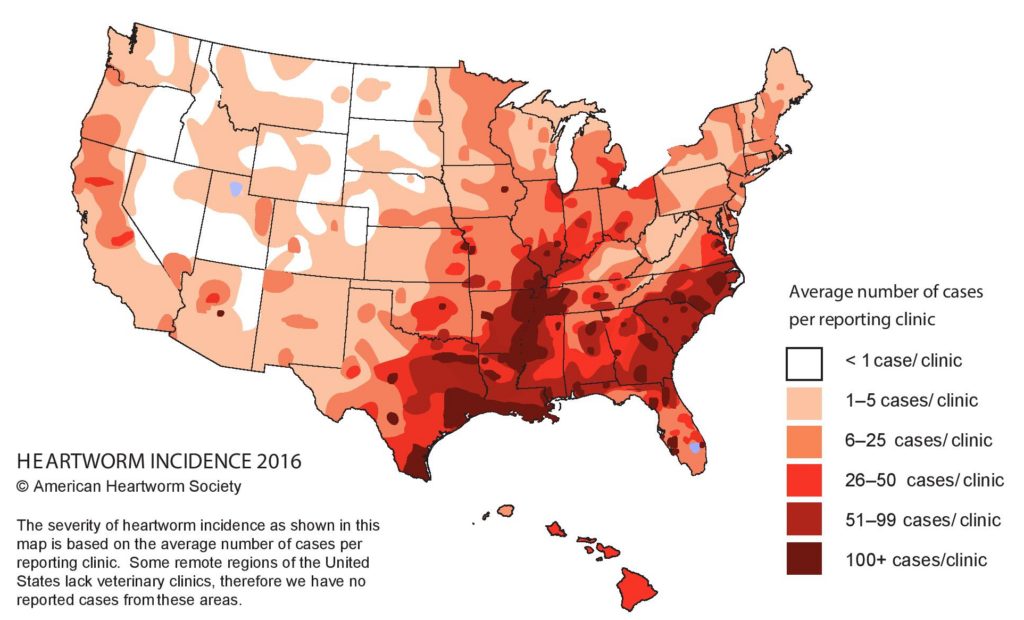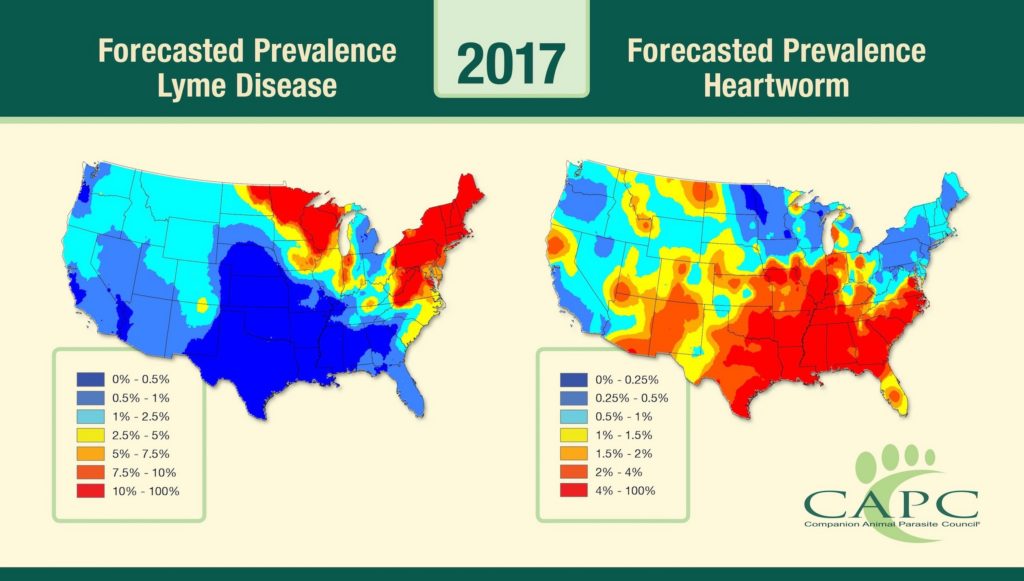As April nears its end so does National Heartworm Awareness Month, an annual educational program to arm and alarm pet owners and the veterinary community of the serious consequences of heartworm disease in dogs. While it focuses on heartworm awareness for one month, it’s really a year-round effort, accentuated by reports and forecasts from two of the industry’s leading organizations in the fight against heartworm.
Both the American Heartworm Society (AHS) and the Companion Animal Parasite Council (CAPC) released some troubling statistics and forecasts concerning not just heartworm but other serious diseases inflicted by parasites.
AHS reports that its latest Incidence Survey indicate that the number of positive cases per veterinary clinic continues to inch upwards.
 The average number of dogs diagnosed per clinic in 2016 rose by 21.7 percent over 2013 numbers, according to AHS President Christopher Rehm, DVM, who also oversees the Rehm Animal Clinic in Mobile, AL. “When veterinarians study our new heartworm incidence map, they will note that the distribution of heartworm cases hasn’t changed dramatically since we surveyed veterinary practices three years ago. What caught our attention is that the number of heartworm-positive cases per practice is on the rise.”
The average number of dogs diagnosed per clinic in 2016 rose by 21.7 percent over 2013 numbers, according to AHS President Christopher Rehm, DVM, who also oversees the Rehm Animal Clinic in Mobile, AL. “When veterinarians study our new heartworm incidence map, they will note that the distribution of heartworm cases hasn’t changed dramatically since we surveyed veterinary practices three years ago. What caught our attention is that the number of heartworm-positive cases per practice is on the rise.”
Of respondents participating in the AHS survey, 23.3 percent reported seeing more heartworm cases in 2016 vs. 2013, while 19.8 percent reported a decline in their practice areas.
CAPC’s annual forecast warns of rough days ahead for heartworm and other diseases. Milder temperatures this winter, coupled with increased precipitation, make for ideal breeding conditions for mosquitoes, the vector responsible for transmitting heartworm disease to dogs.
 Plus, Lyme disease, anaplasmosis and ehrlichiosis transmitted by ticks will be problematic for certain areas of the country. CAPC offers prevalence data at the county level to aid veterinarians in educating pet owners on the importance of annual testing and year-round protection.
Plus, Lyme disease, anaplasmosis and ehrlichiosis transmitted by ticks will be problematic for certain areas of the country. CAPC offers prevalence data at the county level to aid veterinarians in educating pet owners on the importance of annual testing and year-round protection.
Compliance, Fighting the Vector Hold Keys to Preventing Heartworm
Vigilance is the byword in protecting pets against parasites, and heartworm is no exception. No state in the United States is immune from the impact of mosquitoes and the danger of heartworm disease, AHS and CAPC continue to stress.
Veterinarians who reported a drop in heartworm incidence since 2013 (AHS conducts its survey every three years) attribute it to pet owners using heartworm preventives as prescribed. Conversely, those veterinarians (47.8 percent) who reported a rise in heartworm-positive dogs say that pet owners either failed to give preventives, skipped doses or did not give their dogs preventives year-round as contributing factors.

American Heartworm Society (AHS) President, Christopher Rehm, DVM
“We see the results of the AHS Incidence Survey as a good news/bad news story,” says Dr. Rehm. “On one hand, heartworm incidence has increased in a number of states, especially those states in the most heartworm-endemic areas of the Southeast, Mid-South and Delta regions. On the other hand, veterinarians are telling us that there is a straightforward answer to this: (1) convince more pet owners to use preventives and (2) convince them to protect their pets year-round—with no lapses.”
CAPC offers prevalence data that localizes reported parasitic disease activity at the county level for veterinarians to use in their discussions about annual testing and year-round protection.
Its forecast calls for infection with heartworm, which causes a potentially fatal disease and is transmitted by mosquitoes, to be above average nationwide. The only area of the country expected to see below normal heartworm activity is in Western Texas from Amarillo to Laredo. The forecast also predicts the hyper-endemic prevalence seen in the lower Mississippi River region will be even more active than normal. Veterinarians in the Rockies and westward, where heartworm is traditionally not seen, may see a problematic rise in heartworm infections among their patients.
Besides annual testing and year-round preventives, as part of the strategy to stem the tide of heartworm disease, veterinarians should consider a multimodal approach in fighting both the vector – the mosquito – with a topical parasciticide and the heartworm with an oral preventive.
Groundbreaking research conducted by John McCall, MS, PhD, validated the multimodal approach. (See the full details on the design and results of the studies at FightHeartwormNow.com.) In two phases of the study, Dr. McCall showed the value of topical repellent insecticidal products in a “double defense” protocol for protecting dogs against the vector – the mosquito – and use of a preventive against heartworm disease. A professor emeritus in the Department of Infectious Diseases at the University of Georgia College of Veterinary Medicine, the research found that Vectra® 3D, by repelling and killing mosquitoes that may transmit the disease, adds an extra layer of protection along with the heartworm preventive.
“The veterinary community has always been focused on killing the disease after it occurs,” says I. Craig Prior, BVSc, CVJ, president of CAPC and previous owner and medical director of Murphy Road Animal Hospital, an eight-doctor practice in Nashville, Tenn. “If we can go after the mosquito as well, we can be more effective. We know that we have products that do this.
“This is revolutionary because Dr. McCall’s research proved that there’s a better approach in preventing heartworm disease in dogs by combining a topical repellent with a heartworm preventive. It’s broken new ground in heartworm protection and prevention. And as veterinarians, we know the value of a multimodal approach, which we follow in other areas such as osteoarthritis and weight loss,” Dr. Prior adds.


